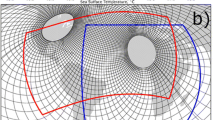Abstract
The sensitivity of tropical Atlantic climate to upper ocean mixing is investigated using an ocean-only model and a coupled ocean–atmosphere model. The upper ocean thermal structure and associated atmospheric circulation prove to be strongly related to the strength of upper ocean mixing. Using the heat balance in the mixed layer it is shown that an excessively cold equatorial cold tongue can be attributed to entrainment flux at the base of the oceanic mixed layer, that is too large. Enhanced entrainment efficiency acts to deepen the mixed layer and causes strong reduction in the upper ocean divergence in the central equatorial Atlantic. As a result, the simulated sea surface temperature, thermocline structure, and upwelling velocities are close to the observed estimates. In the coupled model, the seasonal migration of the Intertropical Convergence Zone (ITCZ) reduces when the entrainment efficiency in the oceanic mixed layer is enhanced. The precipitation rates decrease in the equatorial region and increase along 10°N, resulting in a more realistic Atlantic Marine ITCZ. The reduced meridional surface temperature gradient in the eastern tropical Atlantic prohibits the development of convective precipitation in the southeastern part of the tropical Atlantic. Also, the simulation of tropical Atlantic variability as expressed in the meridional gradient mode and the eastern cold tongue mode improves when the entrainment efficiency is enhanced.













Similar content being viewed by others
References
Bleck R, Rooth C, Hu D, Smith LT (1992) Salinity-driven thermocline transients in a wind- and thermohaline-forced isopycnic coordinate model of the North Atlantic. J Phys Oceanogr 22:1486–1505
Boccaletti G, Pacanowksi RC, Philander SGH, Federov AV (2004) The thermal structure of the upper ocean. J Phys Oceanogr 34:888–902
Bracco A, Kucharski F, Kallummmal R, Molteni F (2004) Internal variability, external forcing and climate trends in multi-decadal AGCM ensembles. Clim Dyn 23:659–678
Carton JA, Cao X, Giese BS, Da Silva AM (1996) Decadal and interannual SST variability in the tropical Atlantic Ocean. J Phys Oceanogr 26:1165–1175
Chang P, Ji L, Li H (1997) A decadal climate variation in the tropical Atlantic Ocean from thermodynamic air-sea interactions. Nature 385:516–518
Da Silva AM, Young CC, Levitus S (1994) Atlas of Surface Marine Data 1994. vol 1, Algorithms and Procedures, NOAA Atlas Series 6, NOAA, Washington, DC, 74 pp
Davey MK et al (2002) STOIC: a study of coupled model climatology and variability in tropical ocean regions. Clim Dyn 18:403–420
Foltz GR, Grodsky SA, Carton JA, McPhaden MJ (2003) Seasonal mixed layer heat budget of the tropical Atlantic Ocean. J Geoph Res 108:3146. DOI 10.1029/2002JC001584
Haarsma RJ, Campos EJ, Hazeleger W, Piola AR, Severijns C, Molteni F (2005) Dominant modes of variability in the South Atlantic: a study with a hierarchy of ocean-atmosphere models. J Clim 18:1719–1735
Hastenrath S (1978) On modes of tropical circulation and climate anomalies. J Atm Sc 35:2222–2231
Hazeleger W, de Vries P, Friocourt Y (2003) Sources of the Equatorial Undercurrent in the Atlantic in a high-resolution ocean model. J Phys Oceanogr 33:677–693
Hazeleger W, Severijns C, Haarsma R, Selten F, Sterl A (2003) SPEEDO - model description and validation of a flexible couipled model for climate studies. KNMI, Technical Report, TR-257. de Bilt, The Netherlands, 37 pp
Huang B, Schopf PS, Pan Z (2002) The ENSO effect on the tropical Atlantic variability: A regionally coupled model study. Geophys Res Lett 29:2039. DOI 10.1029/2002GL014872
Huang B, Schopf PS, Shukla J (2004) Intrinsic ocean-atmosphere variability of the tropical Atlantic ocean. J Clim 17:2058–2077
Jochum M, Murtugudde R, Ferrari R, Malanotte-Rizzoli P (2005) The impact of horizontal resoluton on the tropical heat budget in an Atlantic ocean model. J Clim 18:841–851
Kraus EB, Turner JS (1967) A one-dimensional model of the seasonal thermocline. Part II: the general theory and its consequences. Tellus 19:98–106
Levitus S, Boyer TP, Conkright ME, O’Brien T, Antonov J, Stephens C, Stathoplos L, Johnson D, Gelfeld R (1998) NOAA Atlas NESDIS 18, WORLD OCEAN DATABASE 1998: vol 1: Introduction. US Government Printing Office, Washington DC, 346 pp
Molteni F (2003) Atmospheric simulations using a GCM with simplified physical parameterizations. I: model climatoloty and variability in multi-decadal experiments. Clim Dyn 20:175–191
Moura AD, Shukla J (1981) On the dynamics of droughts in Northeast Brazil—observations, theory and numberical experiments with a general circulation model. J Atm Sc 38:2653–2675
Murtugudde R, Beauchamp J, McClain CR, Lewis M, Busalacchi J (2002) Effects of penetrative radiation on the upper tropical ocean circulation. J Clim 15:470–486
Nobre P, Shukla J (1996) Variations of sea surface temperature, wind stress and rainfall over the tropical Atlantic and South America. J Clim 9:2464–2479
Pezzi LP, Vaillard J, Richards KJ, Menkes C, Anderson D (2004) Influence of ocean-atmosphere coupling on the properties of tropical instability waves. Geoph Res Lett 31. DOI 10.1029/2004GL019995
Ruiz-Barradas A, Carton JA, Nigam S (2000) Structure of interannual-to-decadal climate variability in the Tropical Atlantic sector. J Clim 13:3285–3297
Schneider EK, Zhu Z (1998) Sensitivity of the simulated annual cycle of sea surface temperature in the equatorial Pacific to sunlight penetration. J Clim 11:1932–1950
Weingartner TJ, Weisberg RH (1991) A description of the annual cycle in sea surface temperature and upper ocean heat content in the equatorial Atlantic. J Phys Oceanogr 21:83–96
Wu L, Liu Z (2002) Is tropical Atlantic variability driven by the North Atlantic Oscillation? Geophys Res Lett 29. DOI 10.1029/2002GL014939
Xie S-P, Tanimoto Y (1998) A pan-Atlantic decadal climate oscillation. Geophys Res Lett 25:2185–2188
Zebiak SE (1993) Air-sea interaction in the equatorial Atlantic region. J Clim 6:1567–1586
Zhang D, McPhaden MJ, Johns WE (2003) Observational evidence for flow between the subtropical and tropical Atlantic: the Atlantic Subtropical Cells. J Phys Oceanogr 33:1783–1797
Acknowledgements
We thank Camiel Severijns for his help with setting up the model.
Author information
Authors and Affiliations
Corresponding author
Rights and permissions
About this article
Cite this article
Hazeleger, W., Haarsma, R.J. Sensitivity of tropical Atlantic climate to mixing in a coupled ocean–atmosphere model. Climate Dynamics 25, 387–399 (2005). https://doi.org/10.1007/s00382-005-0047-y
Received:
Accepted:
Published:
Issue Date:
DOI: https://doi.org/10.1007/s00382-005-0047-y




